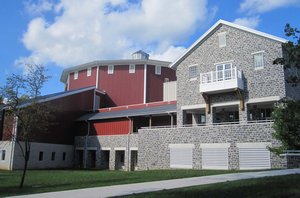Advertisement
Published: November 11th 2010

 The Visitors Center
The Visitors Center
The National Park's Visitors Center is designed to blend into the rural Pennsylvania countryside, and looks vaguely like a collection of farm buildings. There’s something called "the fog of war." When military experts or historians use the term, they’re referring to the uncertainty that descends over a battlefield once fighting begins. The strength of the enemy’s forces, their location, even the strength and location of your own forces, all such information becomes clouded with ambiguity while the battle rages on.
I thought of this phrase last Friday as I stood in the center of the Cyclorama at Gettysburg. This panoramic painting, mounted on the curved walls of a cylindrical room, is designed to make viewers feel as if they are standing in the midst of the battle that took place here. It depicts the afternoon of July 3, 1863, when the Confederate Army made an all-out assault on the Union line along Cemetery Ridge, just outside the town of Gettysburg.
While “the fog of war” may usually be used in a figurative sense, here you can see how the smoke from guns and cannons actually rolled across the fields and orchards around Gettysburg, obscuring the vision of the fighting men and their officers. It’s a chilling effect.
Cycloramas were a popular form of entertainment in the 1800’s. Before TV, before movies, when even photography was in its infancy, entrepreneurs could make big money by hiring artists to paint huge circular canvasses depicting battles or religious epics, erecting buildings to house them, and charging admission. There were hundreds of cycloramas in the U. S. and Europe. This one was first exhibited in Boston in 1884—barely twenty years after the actual battle. Throngs of people came to see it.
And now, thanks to a massive conservation effort to restore the painting and a new building to house it, they’re coming again. The 377-feet-around and 42-feet-high painting is once again being exhibited the way the artist originally intended—with a three-dimensional diorama all the way around, which carries the painted scene into the foreground. The artist would be amazed by the addition of sound and lighting, which help create the experience of immersion and tell the story. Nothing can really capture the reality of war, of course. This is only a taste—there's little here of the fear and the pain and the horror--but it’s enough to make you think seriously about what it must have been like.
In addition to the Cyclorama, the Visitors Center also features a fine new film about the Civil War, narrated by Morgan Freeman, and an extensive museum filled with artifacts and information. All of it made me ponder this bloodiest chapter in American history—perhaps more than I have since first studying about it in grade school.
What I remember being taught in the fourth grade was that the Civil War was fought over slavery. But after spending several hours in this museum, it's clear to me that there was no one simple reason. The definition of our freedom, the preservation of the Union, the fate of slavery and the structure of our economy were all contributing factors.
Most of all, though, these exhibits chronicle the human toll. The Civil War changed the face of America forever. It was fought in thousands of places, from New Mexico and Tennessee, to Vermont and Florida. More than three million Americans fought in it, and over 600,000 men--two per cent of the population--died in it.
A visit to the new Gettysburg National Memorial Park Museum and Visitors Center is well worth your time.
Advertisement
Tot: 0.078s; Tpl: 0.01s; cc: 9; qc: 48; dbt: 0.0518s; 1; m:domysql w:travelblog (10.17.0.13); sld: 1;
; mem: 1.1mb

 The Visitors Center
The Visitors Center